April 21, 2023

By: AEOP Membership Council Member Arnia Goode
A self-driving car, or an autonomous vehicle, is a vehicle that is capable of traveling without human input. Self-driving cars use a combination of sensors, cameras, artificial intelligence, and radar technology in order to operate.
The first-ever pilot mission of a self-driving car occurred in 1995 when a group of robotics students from Carnegie Mellon traveled from Pittsburgh, PA, to San Diego, CA, using a vehicle that was able to steer itself. Since then, there have been numerous advancements in the field. For example, Tesla’s patented Autopilot system, the Tesla Model X, is capable of driving in most situations using cameras and ultrasonic sensors to scan the areas the car drives through.
Some of the key benefits of self-driving cars include fewer car accidents and less time spent by law enforcement on traffic control. According to the National Highway Traffic Safety Administration (2015), almost 93% of car accidents in the United States every year are caused by human error. This includes accidents caused by distracted driving, driving under the influence of alcohol/drugs, and driving drowsy. Humans have a much slower reaction time than robots and are more likely to make a mistake. With self-driving vehicles, all of these causes of accidents are greatly diminished.
According to a survey conducted by researchers at Stanford University, there are over 20 million traffic stops in the United States every year for minor infractions such as not making a complete stop at a stop sign, speeding, not using headlights during the rain, etc (“The Stanford Open Policing Project”, 2015). These traffic stops, while completely necessary, take law enforcement personnel away from other incidents where their skills could be better used. These traffic stops are completely avoidable with the use of self-driving cars because self-driving cars can be programmed to follow certain laws and regulations. According to AAA (2016), the average adult in the United States spends about 293 hours a year driving to and from work. If this mundane daily task was taken away, adults could spend that time sleeping, eating, or doing work, leaving more time to spend with family and friends.
While self-driving cars have a lot of benefits, there are also some disadvantages. One of them is that every single drive is different. There are over a million different situations a driver encounters over a 30-minute drive. It is almost impossible for humans to program the car to know what to do in every single one of these situations. However, what Tesla has begun to research is the use of artificial intelligence in self-driving cars. The car may not be able to identify what to do in each case, but it can learn from prior situations and apply what it has learned to make the best decision possible.
Self-driving cars are the future. While there will be a long time before self-driving cars are truly able to drive without human interference, it is still interesting to learn about some of the possibilities of the future now.
References:
U.S. Department of Transportation – National Highway Traffic Safety Administration. (2015, February). Critical Reasons for Crashes Investigated in the National Motor Vehicle Crash Causation Survey. NHTSA. Retrieved April 21, 2023, from https://crashstats.nhtsa.dot.gov/Api/Public/ViewPublication/812115
Gross, A. (2016, August 8). Americans spend an average of 17,600 minutes driving each year. AAA Newsroom. Retrieved April 21, 2023, from https://newsroom.aaa.com/2016/09/americans-spend-average-17600-minutes-driving-year/
Find a Volunteering Opportunity
Visit our Program Volunteers page for a tool to find the best opportunity for you.
eCYBERMISSION Mini-Grant
The eCYBERMISSION Mini-Grant is intended to support teachers/program leaders as they implement eCYBERMISSION with their teams. Educators (formal and informal) of students in grades 6-9 are encouraged to apply.
